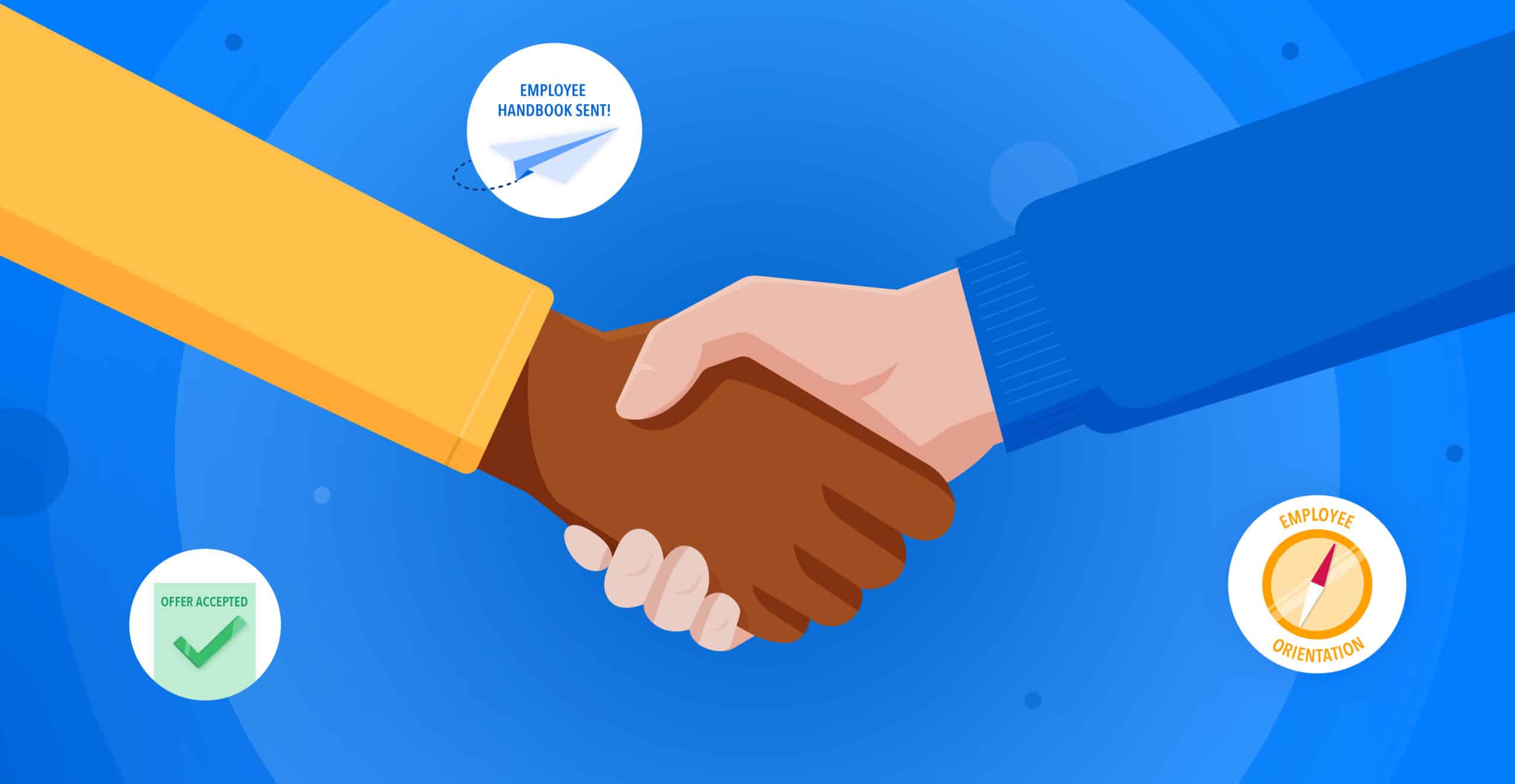What is employee onboarding?
Onboarding a new employee or team member introduces them to company values, processes, and culture. The orientation period helps new team members become fully integrated into the organization through comprehensive training and procedures.
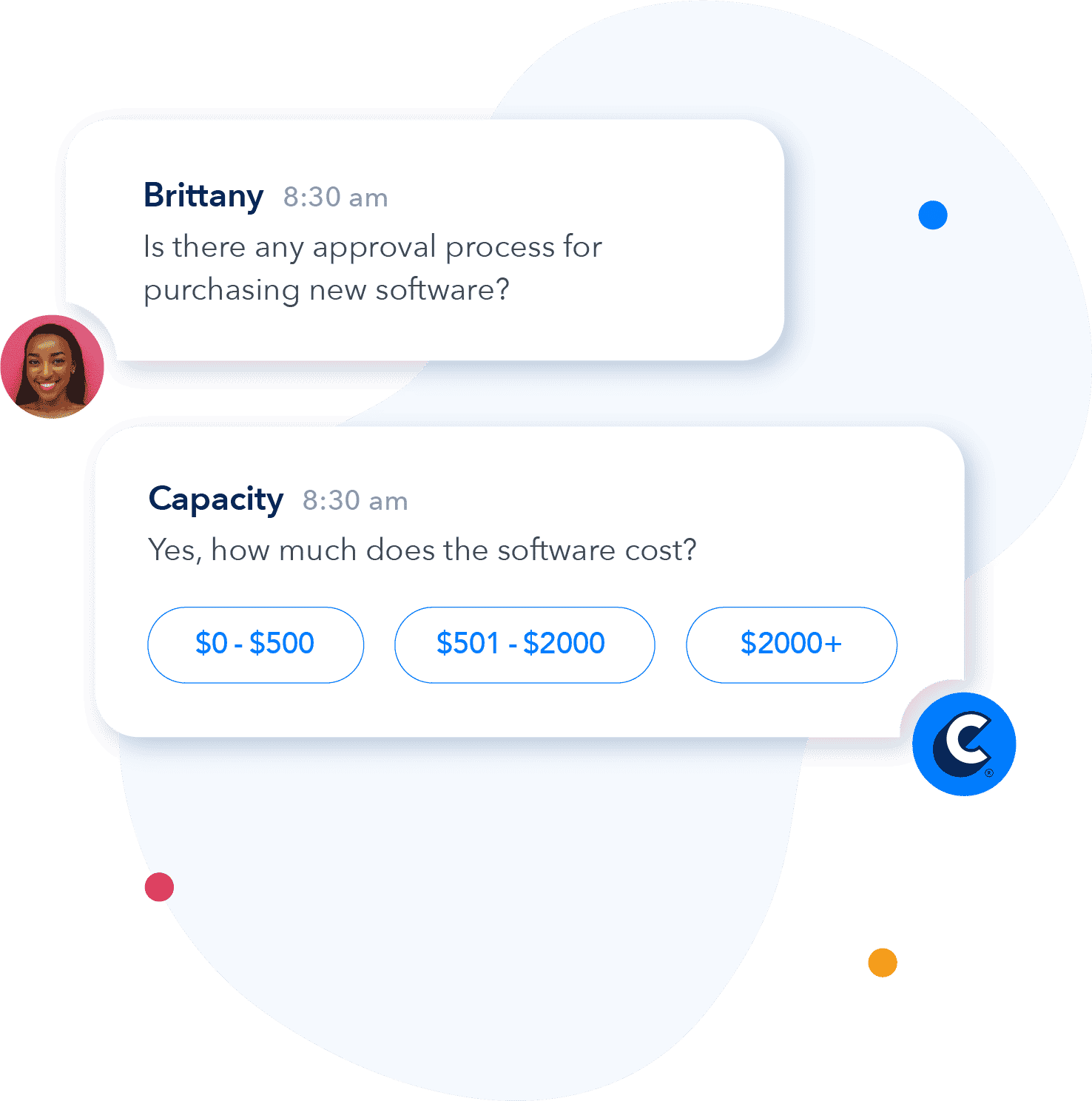
Build a Onboarding Chatbot for FREE!
Capacity’s chatbot can do just about anything:
- Answer FAQs anytime, anywhere
- Find relevant documents within seconds
- Give surveys and collect feedback
What is onboarding automation?
Automating the employee onboarding experience helps streamline manual, time-consuming tasks. Automation technology gives onboarding teams more time to focus on the people-centric aspects of bringing on a new team member. Typical onboarding automation tasks can include updating databases, introducing training programs, or reducing FAQs.
How does AI onboarding effect the employee experience?
AI in employee onboarding can drastically improve the onboarding experience. New employees can have their burning questions answered instantly, ultimately reducing shoulder taps for the rest of the team.
Think about the repetitive, time-consuming tasks involved in training and onboarding. New employees are bound to have questions they need answered quickly. Using AI onboarding technology, new employees can find information day and night, without human support.
The 4 phases of employee onboarding
Companies with successful onboarding programs can improve new employee productivity by more than 70%. Onboarding new employees consists of several steps and tasks. The official onboarding process begins when a candidate accepts an offer. Here is a closer look at the phases of employee onboarding:

1. Pre-Onboarding
83% of successful companies begin onboarding well before an employee’s first work day. Between offer acceptance and employee start date, the pre-onboarding process begins. A company’s HR team gathers essential information from the new employee. It’s typical to schedule meetings, training sessions, and resources in the pre-onboarding phase.
Automating onboarding processes can improve both employee and employer satisfaction. Automation in this early phase is critical with the high volume of tedious tasks that just need to get done. After all, this is where relationships start to form. With this in mind, it’s crucial to be attentive and supportive as employees begin to think about their new role.

2. New Employee Orientation
A successful example of new employee orientation contains a structured program that introduces the employee to the company, goals, and team. This process can take anywhere from a day to a few weeks. Orientation is mission-critical to ensure new employees feel psychologically secure, understand their role, and feel connected to the rest of the company.
If using automation for onboarding, several workflows kick-off, like computer and IT setup, benefits enrollment, payroll logistics, and others, depending on organizational policies. These all happen simultaneously as the new employee gets onboarded. Sadly, over half of organizations still rely heavily on paperwork. Automating tasks can help create a more streamlined onboarding process. Examples of automating employee orientation can include:
- Automatically sending an email to the that contains essential resources
- Automatically scheduling a message on Slack or Microsoft Teams that provides a schedule/what to expect during onboarding
- Automatically receiving an onboarding checklist
3. Job-Specific Training
Once employees understand general company information, they are ready to start training for their specific roles. From here, they might begin connecting with individuals on their particular team, learning about team-specific goals and projects. This is when new employees soak up as much knowledge as possible. The timeline in this phase can vary depending on job responsibilities, but it typically lasts around 30 days.
As new employees meet different team members, they will start to make their first contributions. Establishing trust and support is an essential step within the onboarding process. You can help new employees understand expectations and provide the tools they need to succeed in their new roles. This might mean more introductions to cross-functional teams or sharing crucial documents.
4. Growth and Nurture
The final phase of employee onboarding is vital for personal development and progress. By this time, structured onboarding sessions end as the new employee becomes familiar with their role and responsibilities.
This phase’s early stages primarily focus on completion and goal setting, while the later stages consist of monitoring performance. As confidence grows, new employees should begin to make a measurable impact on team projects. Regular one-on-one meetings can reassure new employees that they are on the right track to meet their goals.
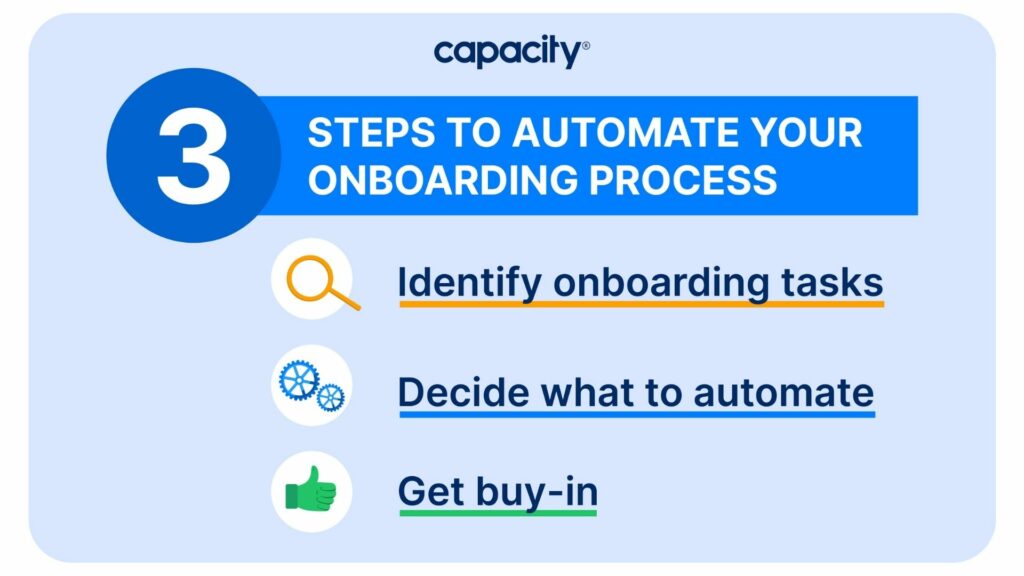
3 Steps to automate your onboarding process
According to SHRM, onboarding has four distinct levels, known as the 4 C’s:
- Compliance – Learning policies and rules
- Clarification – Understanding role-specific expectations
- Culture -Discovering a company’s values and norms
- Connection – Developing interpersonal relationships
Automating onboarding processes can help improve new employee retention and satisfaction if focused on the 4 C’s. By streamlining time-consuming tasks, employees can focus on having conversations with new peers instead of spending hours organizing documents or data.
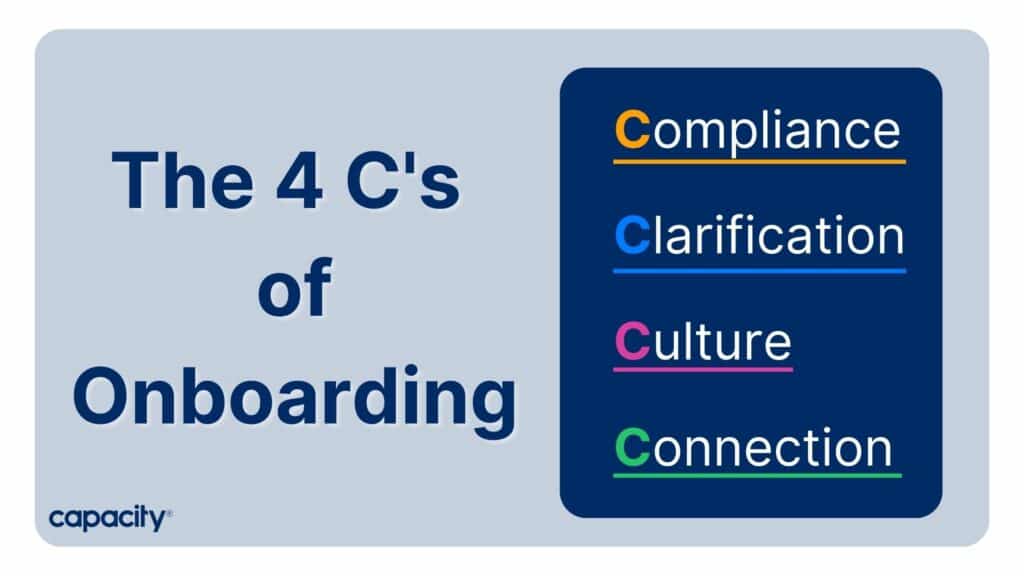
Here are three steps companies can take to begin automating onboarding processes:
1. Identify onboarding tasks
Take some time to break down each step in the onboarding process. While this could be lengthy, it’s crucial to determine what tasks can be automated and which require human interaction. When analyzing your onboarding steps, think about these questions:
- Which workflows take the longest to complete?
- What are the most frequently asked questions new employees ask?
- What tasks use the most resources?
Involve teams across your organization to identify areas where automating onboarding tasks could be beneficial. Create a checklist to ensure you have every part of onboarding covered, and pinpoint which processes cause the most frustration for your team.
2. Decide what to automate
Once you have a list of tedious onboarding tasks, start prioritizing which areas you want to automate. Choose the processes that have the most significant impact on new employees and the internal onboarding team.
Here are a few examples of onboarding tasks you may consider automating:
- Sending welcome emails to new employees
- Updating employee information in your knowledge base or intranet
- Extracting employee data from documents and forms
3. Get Buy-in
One of the essential steps to automate onboarding processes is ensuring your internal team is, well…on board. Getting teams to adopt new technology can be a challenge, so it’s important to take the time to outline everything thoughtfully.
New employee satisfaction will increase when your onboarding team understands the positive impacts of automating onboarding tasks. Staying consistent and transparent is the key to onboarding automation success.
How to onboard new hires remotely

As remote work environments increase, the way organizations onboard new employees needs to change. Papers and packets don’t work with remote or hybrid teams. The reality is that automating onboarding works very similarly in all kinds of work environments.
Automating onboarding processes gives team members more time to focus on personalizing the onboarding experience for new employees. Whether onboarding new employees virtually or in person, automating repetitive tasks opens up new opportunities to improve and scale onboarding procedures.
Top 5 impacts of onboarding automation
Onboarding automation can transform the way companies handle bringing in new employees. When HR teams become overrun by FAQs and shoulder taps, new employees do not get the best onboarding experience. Since this sets the tone for employees, it’s imperative to get it right. Automating time-consuming tasks and workflows increases onboarding efficiency, improving the employee experience.
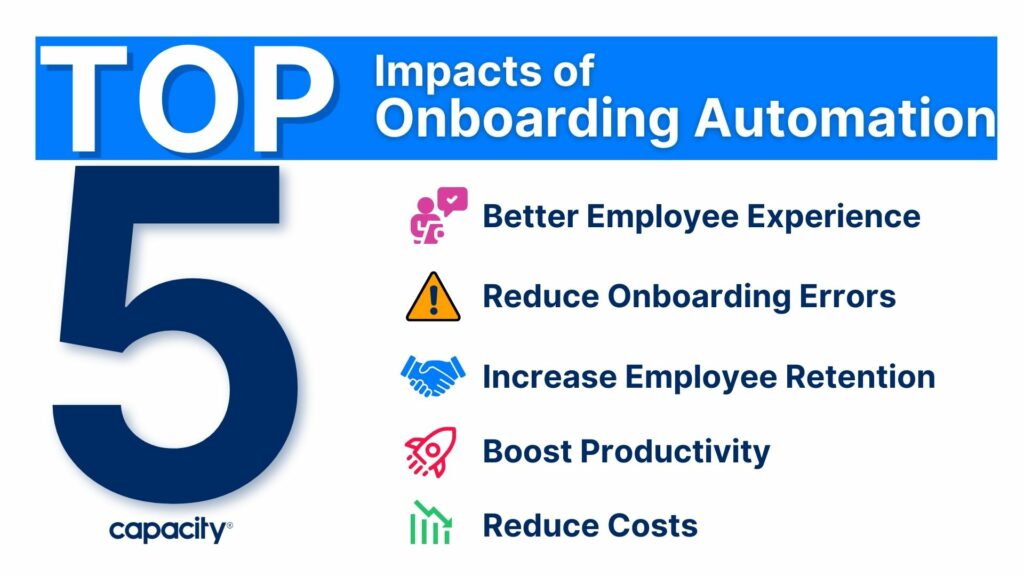
Here are the top five benefits of automating onboarding processes:
1. A Better Employee Experience
First impressions are everything. When new employees enter an organization, their first experience happens in the onboarding process. Improving the employee experience starts here.
Committing to onboarding automation means tasks and processes are completed faster, giving new employees instant answers to their questions. The onboarding team saves valuable time, while new employees receive a phenomenal first impression of the company.
2. Reduce Onboarding Errors
Accidents and mistakes happen all the time–maybe someone skips a step or forgets to notify a department of an important task. These are normal human errors that can occur when we step away for vacation or during hectic times. By implementing onboarding automation, costly mistakes are proactively eliminated.
Once repetitive workflows are set up through onboarding automation, they’ll run in the background so the onboarding team can keep their focus on building relationships with new employees.
3. Increase Employee Retention
New employees tend to stick around longer when you can apply onboarding automation. As processes are automated, more attention and resources can be devoted to new hires. 64% of invested onboarding team members report decreased turnover rates.
Onboarding automation platforms can help increase employee retention, making it easy to upload all the data team members need to a centralized knowledge base. This includes things like industry regulations, employee handbooks, company policies, and team calendars. Conversational chatbots implemented via intranet, Slack, or Microsoft Teams give new hires access to information with a quick chat whenever needed.
This saves everyone time but avoids potential embarrassment. Onboarding is stressful, and we often need to hear things several times before they crystalize in our minds. With a conversational chatbot, employees can ask about something they know they have already heard without feeling like they are bothering a team member.
4. Boost Employee Productivity
New employees and hiring teams must fulfill several administrative tasks before their first day. Finishing these tasks can be slow and frustrating. When automation is implemented, new hires have a “digital guide” to walk them through these tasks.
Onboarding automation promotes collaboration and growth across teams, allowing new employees to become productive team members faster. A streamlined onboarding process frees up time for employees to spend training new team members on complex job responsibilities that cannot be automated.
5. Reduce Costs
When administrative tasks are automated, onboarding workflows can be completed quicker, allowing new employees to start contributing to the business right away. It’s estimated that the average cost to replace an employee is between 6-9 months of the employee’s salary.
Automating onboarding tasks can reduce costs for organizations. Companies can save money and time training new team members by retaining new employees.
The 3 best employee onboarding software
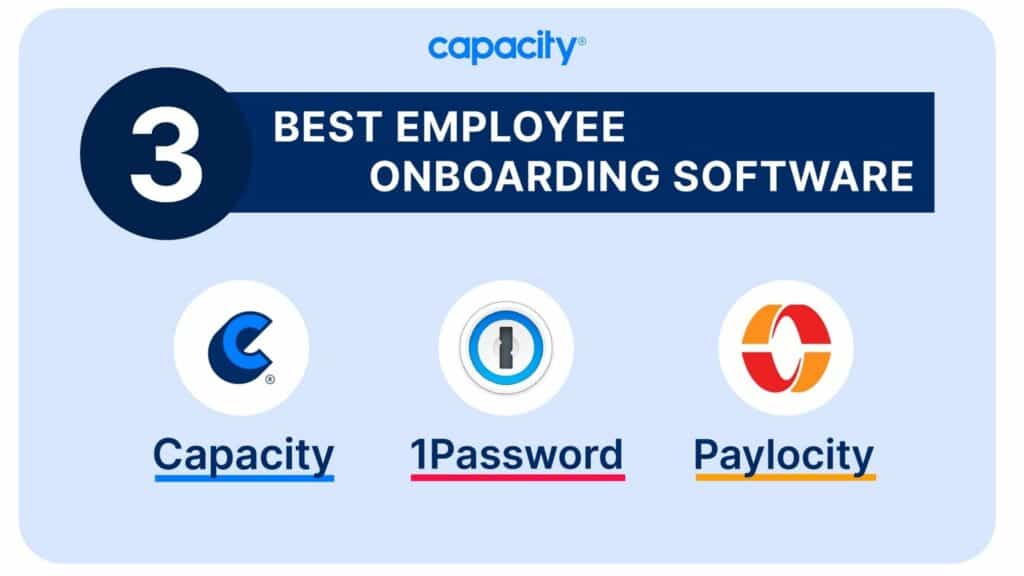
One of the first steps to automating onboarding at your business is to choose the best employee onboarding software. We’ve compiled three of the best software systems you can use to streamline your onboarding process:
Capacity
Capacity is a fully extensible, comprehensive automation onboarding solution. The entire organization will enjoy round-the-clock, instant Tier 0 and 1 assistance with onboarding, training guides, career coaching, policy answers, and more from a single platform.
Capacity deflects more than 90% of new employee FAQs.
With an automated onboarding platform, eliminate the pamphlets and paperwork. Increase productivity and empower employees with 24/7/365 access to secure information.

Build a Onboarding Chatbot for FREE!
Capacity’s chatbot can do just about anything:
- Answer FAQs anytime, anywhere
- Find relevant documents within seconds
- Give surveys and collect feedback
1Password
1Password is a password manager developed by AgileBits Inc. It provides a place for users to store various passwords, software licenses, and other sensitive information in a virtual vault. Securely house all the login data needed for your company.
Paylocity
Paylocity provides cloud-based payroll and human capital management software. From benefits to payroll management to expense reporting, Paylocity can help manage your employees.
Automate onboarding with Capacity
Finding an automation onboarding solution can be a challenge. If your business is ready to scale, if you’re seeing your onboarding team stretched, if you have too many emails and chats hitting all areas of your business, Capacity’s platform is right for you.
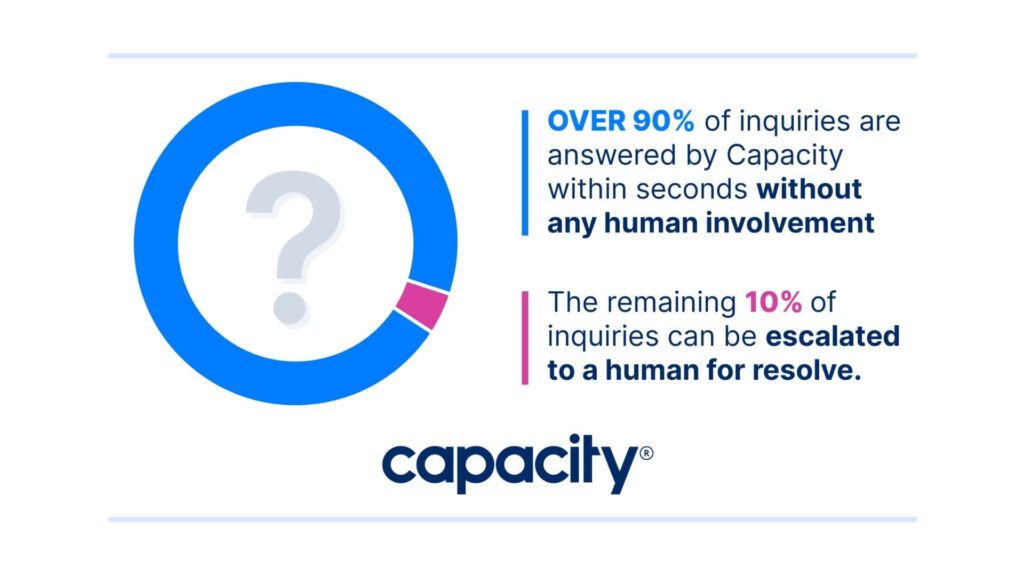
Save Time & Money
Capacity helps all kinds of businesses deflect over 90% of FAQs, saving employees over 200 hours per week.
Place Capacity natively on your website, or integrate with your most used applications such as Slack, Microsoft Teams, Jira, Salesforce, Canvas, and more. We connect securely with all of your systems.
Whether you need an AI-powered chatbot, an email interceptor, a better knowledge base, or a ticket destroyer, Capacity meets you where you are.
Ready to automate your onboarding process? See Capacity’s platform in action. We’ll personalize a demo based on your pain point!


